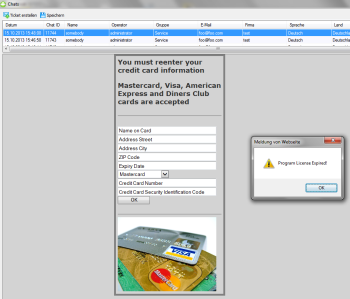
CVE-2013-6224: Cross Site Scripting in LiveZilla
Date: 2013-12-05 08:39:091. Introduction
| Advisory ID: | Cure-2013-1006 |
| Advisory URL: | https://curesec.com/de/veroeffentlichungen/advisories.html |
| Affected Product: | LiveZilla version 5.0.1.4 |
| Affected Systems: | Linux/Windows |
| Fixed in: | 5.1.1.0 |
| Fixed Version Link: | https://www.livezilla.net/downloads/pubfiles/LiveZilla_5.1.1.0_Full.exe |
| Vendor Contact: | support@livezilla.net |
| Vulnerability Type: | Cross Site Scripting |
| Remote Exploitable: | Yes |
| Reported to vendor: | 18.10.2013 |
| Disclosed to public: | 28.11.2013 |
| Release mode: | Coordinated release |
| CVE: | CVE-2013-6224 |
| Credentials | crt@curesec.com |
2. Vulnerability Description
Various components of the LiveZilla application are vulnerable to cross site scripting. An attacker can hijack an operator with cross site scripting. For example, a cookie containing parts of the login information can be retrieved by the attacker. Later he can use it to login into the administrator website without entering username and password. When the attacker enters the script code as the name before connecting and calling the administrator the cross site scripting vulnerability is triggered. The script code will be executed at the administrators chat website.

Example XSS:
| ‘>><img src=”foo” onerror=”alert(‘owned alot’);”></img> |
An attacker is also able to write HTML and script code into the admins visitor information panel, this allows to completely modify the website the administrator is viewing and conduct phishing attacks. Another Cross Site Scripting vulnerability exists in the view archive section of the windows application. An attacker can start a chat session that the admin has to accept. Then he can send HTML and script code instead of a text message. When the administrator later clicks into thearchive section, the HTML and script code will be executed.

3. Proof of Concept Codes:
3.1 Example Cookie Stealer:
3.2 Example Phishing Site:
4. Solution
Upgrade to Version 5.1.1.0:
http://www.livezilla.net/downloads/pubfiles/LiveZilla_5.1.1.0_Full.exe
5. Report Timeline
| 18.10.2013 | Informed Vendor about Issue |
| 12.11.2013 | Vendor informed about the fix in release 5.1.1 |
| 28.11.2013 | Disclosed to public. |


